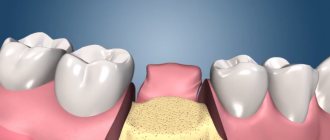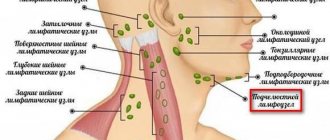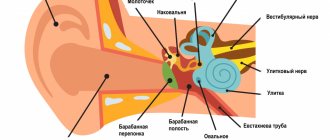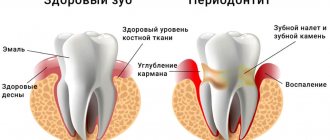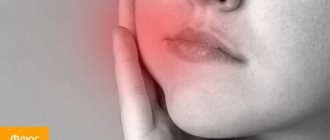Content:
- Causes of pathology
- Signs of inflammation of the submandibular lymph nodes 1.1. First stage 2.2. Second stage 2.3. Third stage
- How to cure an enlarged lymph node in the submandibular area
- Prevention of the inflammatory process
Inflammation of the submandibular lymph node is one of the most common types of lymphadenitis.
Its development is caused by inflammatory processes occurring in the oral cavity and less often in other parts of the body. Often the problem occurs with advanced caries, pulpitis, gingivitis, and inflammatory lesions of the tonsils. It is also caused by throat diseases. Let's take a closer look at why the submandibular lymph nodes are enlarged and what should be done to normalize the situation.
What is submandibular lymphadenitis, stages of development
Submandibular lymphadenitis is inflammation of the cervical and submandibular lymph nodes
, which can be acute or chronic. Often the disease is secondary, that is, it does not occur independently, but as a symptom of a primary infection.
Acute stage
In the acute form of the disease, one lymph node or several may become inflamed. Depending on what kind of exudate is contained in the inflamed node - pus or serous fluid - lymphadenitis is divided into purulent and non-purulent. The acute form of the disease is treated by removing pus from the lymph node and eliminating the root cause of inflammation.
If there is pus inside the lymph node, there is a danger of it breaking through and infecting surrounding tissues.
Chronic stage
The transition of the disease to the chronic phase is a consequence of the lack of adequate treatment. The node no longer increases in size and hardens. The pain syndrome intensifies, and severe intoxication of the body occurs. The skin around the node becomes purple.
Compared to the acute phase of the disease, with chronic lymphadenitis there is a clearly noticeable increase in the area of inflamed tissue around the lymph node
. The danger of this form of pathology is that it may require removal of the lymph node.
Causes of pathology
If the lymph node changes its size, it can be assumed that a viral or bacteriological infection has spread. Taking into account the localization of the lesion, the doctor understands exactly where the source of the disease is located and which organs need urgent medical attention.
Among the dental provocateurs of enlarged submandibular lymph nodes:
- inflammation of the salivary glands;
- gingivitis;
- pulpitis;
- flux;
- stomatitis;
- alveolitis;
- periodontitis;
- deep caries;
- inflammation occurring under the crowns.
But the violation is not always associated specifically with dental diagnoses. Its reasons are:
- Respiratory diseases: pharyngitis, laryngitis, rhinitis.
- Pathologies related to the bone structures of the skull: damage to the bone structures of the lower jaw, damage to the temporomandibular joint, articular capsule.
- Infections: sore throat, measles, tonsillitis, otitis media, chicken pox, mumps. In all these cases, the lymphatic tissues swell a few days after the first symptoms of the disease appear.
- Specific pathologies caused by pathogenic pathogenic agents: toxoplasmosis, tuberculosis, syphilis, gonorrhea.
- Oncological neoplasms. Lymphatic tissue always reacts very sharply to tumor growth. Enlarged submandibular lymph nodes sometimes indicate the presence of a neoplasm in the area of the tongue, neck, or salivary glands.
- Autoimmune disorders. Always associated with disruptions in the functioning of the immune system. Then, by mistake, lymphocytes begin to treat healthy cells as dangerous pathogens. They destroy them, causing inflammation of the lymph nodes.
- Hyperthyroidism. With an exacerbation of this disease, the neck and cheek area swells, the lymph nodes become more voluminous.
In young children, parents may notice large round “balls” under the jaw during the period of active teething. This often causes an increase in body temperature. There is no need to be afraid of such symptoms. It is associated precisely with the inflammatory process provoked by the eruption of milk units. But, if the situation does not return to normal within three to five days, it is still worth showing the baby to a pediatric dentist, surgeon or pediatrician.
Signs of inflammation of the submandibular lymph nodes
How the disorder manifests itself depends on how far the disease process has progressed. If you do not carry out the necessary therapeutic measures, one stage will quickly pass into another.
First stage
The size of the lymph nodes changes very slightly, but the person already feels that they hurt when pressed. Discomfort occurs when turning the head. Body temperature often rises and a sore throat appears. A tickle or dry, unproductive cough is annoying. Pain occurs only on one side of the neck or on both sides at once. The first case is more likely if it is a viral disease.
Second stage
It is called “acute lymphadenitis”. Now the lymph node can be distinguished visually - it becomes convex and protrudes forward. Externally it resembles a subcutaneous ball. Its diameter reaches three centimeters, but can be more impressive.
The node is painful to the touch. Because of this, it is difficult for the patient to turn and tilt his head, and open his mouth wide. The mobility of the upper and lower jaw is significantly limited.
The pain may radiate to the cheek or ear. Body temperature increases. Overall performance decreases.
Third stage
Called purulent lymphadenitis. Here, the inflammatory process even affects structures adjacent to the lymph node. The patient complains of pain in the throat, collarbone, armpit, and head. The nerve endings of the teeth may become inflamed. Then acute toothache occurs.
Pus formed in lymphoid tissues consists mainly of necrotic cells. If it gets into the blood (and such a possibility always exists), the outcome can be extremely unfavorable, so the inflammatory process should not be started.
Patients can understand that the submandibular lymph node is inflamed and needs treatment as soon as possible by the following signs:
- the “ball” enlarges and becomes red or bluish;
- every day it becomes more dense and solid;
- the skin located above the lymph node takes on a red tint and is hot to the touch;
- the lower jaw area swells.
Lymphadenitis is inflammatory changes in one or a group of lymph nodes. Lymphatic formations of all areas of the body can be affected. Lymphadenopathy of the cervical and submandibular region is most often observed in medical practice. This disease usually has a secondary genesis. If the inflammation becomes purulent, then the infection may break through with the development of abscesses and phlegmons. From the submandibular region, inflammation can move along anatomical formations to various sections. Such situations can be life threatening.
A huge number of diseases can indirectly or directly lead to inflammation of the lymph nodes, especially infectious diseases. The human lymphatic system belongs to the body's immune system and is represented by lymphatic vessels and lymph nodes. Immune cells circulate in this system. Lymph (fluid that flows from organs and tissues through lymphatic vessels to the lymph nodes) carries particles of pathogenic microorganisms for recognition by immune cells. In the lymph nodes, preparation and activation of immune cells (mainly lymphocytes) take place, which migrate to the pathological focus, destroy bacteria and other pathogens, resulting in recovery. There are other possible causes of lymphadenopathy: tumors of the immune system, systemic diseases, helminthic infestations, tumor metastases and others, but they are much less common and their main symptoms dominate over enlarged lymph nodes (which, by the way, is not always inflammatory in nature). Most often, inflammation of the regional lymph nodes of the submandibular region is odontogenic. This means that the main source of infection is the inflammatory process in the oral cavity. These are most often dental problems - periostitis, periodontitis, periodontitis, pulpitis. Inflammatory diseases of the respiratory system lead to enlargement of the lymph nodes in the cervical region - parotid, tonsillar, occipital and others. There are catarrhal and purulent forms of inflammation. Depending on the type of process, treatment tactics will change.
Having discovered such changes, patients usually first turn to a therapist. However, as mentioned earlier, if the inflammation is localized specifically in the submandibular nodes, one should assume an odontogenic nature and consult a dentist.
The clinical picture may differ depending on the location of the primary lesion. Lymphadenitis itself is accompanied by palpable formations in the submandibular region. They will have an elastic consistency, and painful sensations occur upon palpation. There may be discomfort while eating, but the general condition usually does not change. Such symptoms are characteristic of the catarrhal (serous) process. If inflammation progresses, the lymph node can be completely destroyed by a purulent process. In this case, the skin over the node becomes hot to the touch, turns red, and body temperature rises depending on the type of inflammation (an abscess or phlegmon develops). strong painful sensations of a tugging or pulsating nature occur already at rest.
Lymphadenitis can be diagnosed by inspection and palpation of the affected area. Depending on what the doctor suspects as the cause of the inflammation, appropriate diagnostic methods will be prescribed. Be sure to conduct an examination of the oral cavity: inflammatory changes in the teeth, oral mucosa, tonsils, pharynx, larynx and other organs can be noted. The dentist may prescribe a panoramic X-ray or an X-ray examination of the sinuses. All patients are shown a general blood test. In the absence of pathology on the part of the dentofacial apparatus, a consultation with a therapist or otolaryngologist is indicated. In some situations, consultation with an oncologist is required.
Additional methods include smears from the oropharynx to determine the causative agents of the infectious process, biochemical blood tests, ultrasound of regional areas (will reveal an increase in nodes inaccessible to palpation), various methods of visualization of the head and neck organs (for the presence of oncological pathology), puncture biopsy of the affected lymph node with cytological and histological examination and other methods.
Treatment depends on the type of inflammation. In the case of a purulent process, surgical treatment is indicated - opening and draining the lesion. If the inflammation is catarrhal, then a dentist or otolaryngologist treats the underlying disease (pharyngitis, tonsillitis, laryngitis, periodontitis, periostitis, pulpitis and others). In such a situation, the lymph nodes are not opened under any circumstances, but conservative therapy is carried out: UHF therapy, ointment dressings, heating using a dry heat source.
How to cure an enlarged lymph node in the submandibular area
Therapy must be carried out under medical supervision. Its main goal is to eliminate the infection that caused the disorder. If the root cause of the condition is not established, it will not be possible to be completely cured.
If the problem is related to an oral disease, mandatory treatment is carried out. For severe inflammatory pathologies of internal organs, antibiotic therapy is carried out. For pathologies of a viral nature, patients are prescribed antiviral drugs.
If the examination reveals that pus has accumulated inside the tissues, it is drained using a drainage tube. Additionally, a puncture is taken to recognize the pathogen and understand whether the disease has a benign or malignant course.
As soon as the infectious focus disappears, the lymph nodes begin to shrink, stop hurting and gradually reach their normal state.
Prevention of the inflammatory process
To reduce the risk of developing lymphadenitis, you must strictly follow the recommendations:
- Have annual preventive examinations at the dental clinic. Treat all emerging oral diseases in a timely manner. Avoid caries and take care of your gums.
- Do not ignore the presence of infections and treat them. During therapy, strictly follow all medical prescriptions.
- For any damage to the skin, treat wounds with antiseptics. This minimizes the risk of contracting an infectious disease.
- If you feel unwell, consult a doctor and get laboratory tests. This simple measure allows you to detect violations at the earliest stages.
It is necessary to understand that using “grandmother’s” methods for inflamed lymph nodes is dangerous. So, under no circumstances should you heat the inflamed area or apply cold compresses to it. It is unacceptable to massage him or put pressure on him. All of these actions can make the situation worse. Then it will be much more difficult to reverse the disease.
Therapeutic measures for lymphadenitis
If a lump appears under the skin on the lower jaw, it is certainly necessary to consult a specialist to clarify the diagnosis. Moreover, it does not matter whether palpation causes pain or does not cause any discomfort at all. Usually the first visit is to a therapist, who then refers you to the right doctor to get rid of the underlying disease.
When inflammation is caused by an infectious disease, no special local treatment is usually prescribed. All efforts are directed towards getting rid of the root cause. If infection occurs with streptococci or staphylococci, therapeutic measures will take quite a long time. Even after treatment, re-infection and enlargement of the lymph nodes cannot be ruled out.
If the problem arose due to dental diseases, then first of all they eliminate inflammation of the pulp or periodontitis, treat caries and get rid of periodontal lesions. To achieve a reduction in the volume of the lymph node, it is necessary to carry out high-quality sanitation of the oral cavity. Sometimes even a minor problem can cause similar symptoms.
The same thorough treatment is necessary for diseases of the upper respiratory tract. For example, tonsillitis is an extreme source of infection. During its course, not only the submandibular lymph nodes can enlarge.

